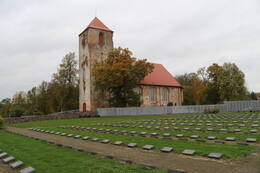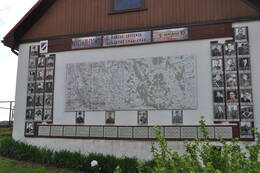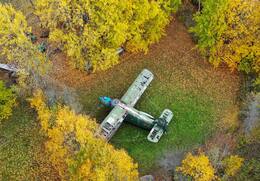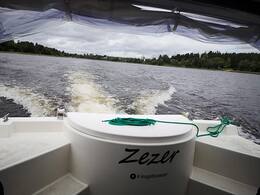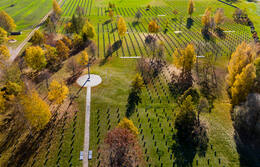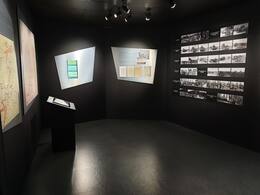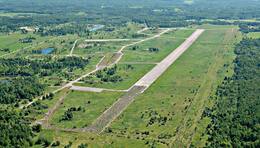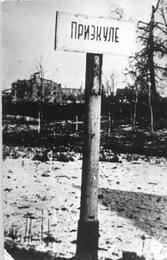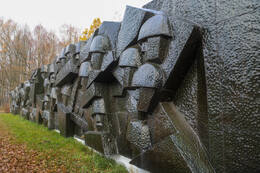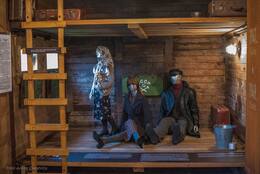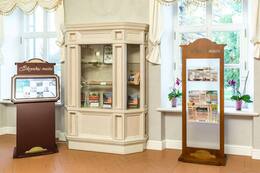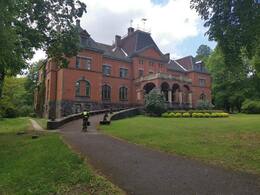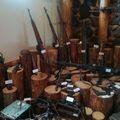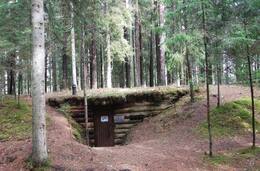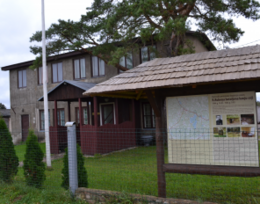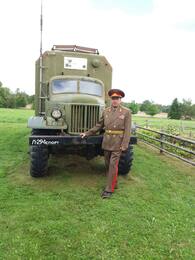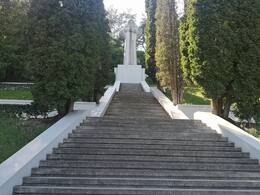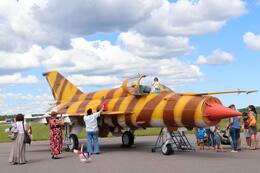Along the battlefields of Kurzeme Pocket to Soviet Heritage adventure in Dundaga
Lestene Brothers' Cemetery
Located in Tukums region, Lestene, next to the church.
The creation of the mass grave in Lestene began in 1998. It is the second largest military cemetery in Latvia, where more than 1,300 Latvian legionnaires are buried. Only after the restoration of the Republic of Latvia was it possible to rebury Latvian soldiers who fell in World War II from various places.
The Latvian Legion was a combat unit of the German army, formed mainly from illegally mobilized Latvian residents. The soldiers perceived their presence in the legion as a fight for the restoration of Latvian independence, despite the fact that it took place within the ranks of the German armed forces and Germany had occupied Latvia. There was no other military force that could delay the return of the Soviet occupation. The Latvian legionnaires fought against the Red Army, which had liquidated the independence of Latvia, destroyed its army and committed crimes against the civilian population. About 110,000–115,000 soldiers fought in the ranks of the German army, about 30,000–50,000 of them lost their lives on the battlefields.
Nowadays, in Lestene you can visit the Brothers' Grave, next to which is the Lestene Church. It is an outstanding example of Baroque sacred art. In the ancient church tavern you can get acquainted with an exhibition dedicated to the history of the Latvian Legion. The central image of the brothers' grave, "Homeland - Mother - Latvia", was created by sculptor Arta Dumpe. Nearby is the Lestene Manor, which belonged to Latvian Army General Mārtiņš Hartmanis before World War II.
Tours of the Lestene Church can be booked with the parish priest of the Lestene Evangelical Lutheran Church, Inguna Kokina, phone +371 29993743.
Lestene Brothers' Cemetery, Memorial Exposition and bunker
Lestene Brothers’ Cemetery is located in Tukums municipality, Lestene, next to the Lestene church. The construction of the Brothers’ Cemetery in Lestene began in 1998. It is the second largest military cemetery in Latvia, and more than 1,300 Latvian legionnaires are buried here. Only after regaining the independence, it was possible to rebury Latvian soldiers who fell during World War II. The Latvian Legion was a combat unit of the German Army, formed mainly from illegally drafted Latvians. The soldiers thought of their presence in the legion as something that had to be done to be able to restore Latvia’s independence, despite the fact that they were in the ranks of the German armed forces and that Germany had occupied Latvia. Latvian legionnaires fought against the Red Army, which had destroyed Latvia's independence and its army and committed crimes against civilians. Between 110,000 and 115,000 soldiers fought in the ranks of the German Army and about 30,000–50,000 of them never left the battlefield. The Brothers’ Cemetery central theme ‘Motherland – Mother – Latvia’ was created by the sculptor Arta Dumpe. Across the road an exhibit dedicated to the history of the Latvian Legion has been created in a former pub. Right next to it the men of the Latvian Officers Association, under the leadership of Captain Jānis Slaidiņš, have built an underground bunker to show how soldiers and officers lived on the front lines.
Kurzeme fortress museum in Zante
Will be open from May 1st.
Boat trip in Ciecere lake by the boat “Zezer”
During the ride with the recreational boat “Zezer” along Lake Ciecere near Brocēni you can listen to the audio guide and captain's stories about Lake Ciecere and the city of Brocēni on its shores, World War II events near Lake Ciecere, trenches on both sides of the lake and the Oak Island, as well as the tank route running along an observation tower and the tank that is said to be sunk in the lake. The audio guide is available in Latvian, Lithuanian, English, and Russian languages. The ride takes 1 hour 15 min.
Saldus German Soldiers' Cemetery
The Saldus German Soldiers' Cemetery is located on the Saldus–Ezeres highway. The cemetery, which covers an area of 8 hectares, contains the remains of around 25,000 German soldiers, as well as some Latvian legionnaires. Reburials have been taking place since 1997.
From May 1 to October 1, an exhibition about the battles of Courland can be viewed in the memorial room. During this period, the memorial room is open on weekdays from 9:00 to 17:00, and on Saturdays and Sundays a guide is also working in the cemetery. Registers of soldiers buried in the Saldus German soldiers' cemetery and soldiers who fell throughout Latvia are also available.
Ezere local history repository “Muitas Nams” (Customs House)
The Ezere Customs House is located in Ezere near the Saldus-Mažeikiai highway at the Latvian-Lithuanian border. The act of surrender of the German Army units ‘Kurzeme’ (Kurland) surrounded in the so-called ‘Courland Pocket’ was signed in this building on 8 May 1945. It is believed that World War II actually ended in Ezere. The customs house has an exhibit covering the events of the end of World War II and exhibits detailing the history of Ezere parish from ancient to modern days. In the morning of 7 May 1945, the commander of the Leningrad Front, Marshal L. Govorov, sent an ultimatum to the command of the army group ‘Kurzeme’ to lay down arms. The act of surrender was signed by the involved parties on May 8 and it detailed the procedure of surrender, weapons collection points, documents and information to be submitted and other practical measures.
Vaiņode air base
Vaiņode airfield still has 16 Soviet-era aircraft hangars and an 1800 m section of the once 2500 m long runway. The airfield can only be visited with a previous booking. Vaiņode airfield was established during the Latvian independence as one of the cradles of Latvian aviation and was later one of the largest military airfields in the Baltic States. In 1916, two hangars for German Army airships were built. Airships were used to gather intelligence and bomb the positions of the Russian Army. Later the city of Riga bought the airship hangars and used their roof structures to build the pavilions of the Riga Central Market. In May 1940, the 31st Fast Bomber Aviation Regiment of the Red Army moved to Vaiņode, and the construction of a standardized concrete slab runway began. At the end of the summer of 1944 the partially completed airfield was used by various German aviation units, however, at the end of World War II, the same airfield was used by the Red Army aviation units fighting the German Army group called ‘Kurzeme’. After World War II the Soviet Air Forces were stationed in Vaiņode until 1992.
Priekule Memorial Ensemble of Warrior’s Cemetery
The Priekule Memorial Ensemble of Warrior’s Cemetery is on the Liepāja-Priekule-Skoda road and is the largest burial site of Soviet soldiers of World War II in the Baltics. More than 23,000 Soviet soldiers are buried here. Operation Priekule was one of the fiercest battles in Kurzeme Fortress that took place from October 1944 to 21 February 1945. The Battle of Priekule in February 1945 lasted seven days and nights without interruption and had a lot of casualties on both sides. Until Priekule Warrior’s Cemetery was transformed into a memorial, the last monument of the outstanding Latvian sculptor K. Zāle (1888-1942) was located here to commemorate the independence battles in Aloja. Between 1974 and 1984, the 8 ha Priekule Warrior’s Cemetery was transformed into a memorial ensemble dedicated to those who fell in World War II. It was designed by the sculptor P. Zaļkalne, architects A. Zoldners and E. Salguss, and the dendrologist A. Lasis.
The centre of the memorial holds a 12 m tall statue called the ‘Motherland’, and names of the fallen are engraved on granite slabs. Until Latvia regained its independence, the Victory Day was widely celebrated every year on May 9.
Cattle wagon used for deportations – museum at Skrunda train station
To commemorate the deportations of June 1941 and March 1949, a memorial stone and a four-axle wagon, which also serves as the museum dedicated to deportations, was erected at the Skrunda railway station. This is the first wagon-type museum in Latvia that holds a permanent exhibit of photos, letters, memoirs, documents and various items made by the people deported from the Skrunda station. Skrunda station was a location where deportees were gathered, and one of the three stations in the region to which people from the Skrunda and the Kuldīga area were brought. In 1941, the family of the first President of the restored Republic of Latvia, Guntis Ulmanis, was deported from here to Krasnoyarsk Krai in Siberia.
With the help of deportations, the Soviets dealt with supporters of the national partizans’ and at the same time intimidated the remaining rural population, forcing them to join the collective farms.
Skrunda Manor and exposition of Skrunda locator
Skrunda manor has an exhibit about the Skrunda radar (Skrunda radio location station) and the activities of the Latvian Popular Front in Skrunda. The Skrunda radio location station nicknamed ‘Kombināts’ (The Plant) was a USSR missile early warning system in the western sector. Location ‘Skrunda-2’ was a special town (в/ч 18951) created 5 km from Skrunda in the direction of Kuldīga for the needs of the USSR military. The radar station Dņepr operated from here and a new, more modern station Darjal was being built. Construction was stopped and the radar station Darjal was blown up on 4 May 1995. In compliance with an international agreement the radar station Dnieper was shut down on 31 August 1998.
Pelči Manor
The Pelči Manor is located in Pelči parish, Kuldīga municipality. Tours of the manor house must be booked in advance. The Pelči Manor was built between 1903 and 1904, and this work by architect Wilhelm Neumann is one of the most outstanding manors of the early 20th century in Latvia. Its architectural language involves compositional principles and elements from Renaissance, Baroque and Art Nouveau. Between the late 19th century and 1920, the manor was owned by the Fürst von Lieven family.
From 1944 to 1945, the Pelči Manor was used as headquarters of the German Army Group ‘North’ (known as Army Group ‘Kurzeme’ as of 25 January 1945).
The headquarters of the Army Group ‘North’ moved from Sigulda to the Pelči Manor on 23 September 1944 in view of the planned retreat of the 18th army force from Estonia. The headquarters remained there approximately until mid-May 1945 when, after the capitulation of Army Group ‘Kurzeme’, information and documents were handed over to Red Army officers.
Museum of the National Resistance Movement in Renda
The museum is located a few kilometres from the centre of Renda parish. The exhibit tells about the 50-year-long resistance movement in Latvia: resistance to the first Soviet occupation, resistance to the Nazi German occupation, and the armed and non-violent resistance to the Soviet occupation. The exhibit is located in two buildings. The first building houses evidence of the first Soviet occupation and German occupation. The exhibit showcases a restored barn building where the focus lies on the National Partisan War. Between the two buildings there is a bunker with an authentic layout and trenches used by soldiers. Located near the museum in Renda, excavations, blindages and an obstacle course serve as a training ground for youth guards and anyone interested. Visits must be booked in advance.
One of the largest battles of the national partisans, called the Āpūznieki Battle, took place in January 1946 not far from here. The battle saw the Kabile National Partisan Group overpower much larger forces of the occupying power. Featuring information stands, the battle site is now home to a rest area.
Rubenis' battalion bunker and battlefields
The restored dugout of the 2nd Company of the Rubenis Battalion is located in a forest by lake Ilziķi in the Usma parish. The dugout can be viewed from the outside for free at any time. However, tours inside the dugout must be booked in advance.
The Battalion of Lieutenant Robert Rubenis was part of a military unit formed by General Jānis Kurelis, and it is known for not surrendering to the German troops and showing heavy resistance. From November 14 to December 9 in 1944 fierce battles were fought in Ugāle, Usma, Renda and Zlēkas parishes between forces of the 16th German Army, SD and SS units under the command of the Police General Friedrich Jeckeln, and the battalion of the Kurelian unit commanded by Lieutenant Roberts Rubenis. The men under Rubenis’ command were well armed and organized and did not associate themselves with any of the two hostile occupying powers. Their actions are considered to be the most wide-spread and longest in the history of the Latvian national resistance movement. In battles near Renda and Zlēkas about 250 German soldiers fell, while only 50 casualties were suffered by Rubenis’ men. The events of those days are represented by the restored dugout in the forest (sod-covered, log cabin dug in the ground) where the men of the Rubenis Battalion once stayed.
Rubenis' battalion museum
Rubenis’ Battalion Museum is located in Ugāle. It is dedicated to the Battalion of R. Rubenis, who served and fought under General J. Kurelis in Kurzeme in 1944, the activities of the Kurelians and the national resistance movement. Museum has an exhibit on the activities of the Latvian Central Council (LCC) and its Ventspils group, as well as the LCC Memorandum with 188 signatures and photographs of signatories that is included in the Latvian National Register of the UNESCO Memory of the World Programme. The LCC was a joint centre of Latvia's highest political leadership with an underground government that operated during the occupation of Latvia from 1943 to 1994. It was formed with the aim of coordinating the activities of various Latvian resistance movements in order to restore Latvia's national independence. The museum also offers a trip to places significant to the history of the battalion (settlement with a reconstructed bunker in the Usma parish, battlefields in Renda and Zlēkas parishes, etc.).
Collection of Soviet Military Vehicles
Edgars Kārklevalks owns a guest house called Pūpoli in the Dundaga region, and for more than 15 years he has been taking people on historical and educational trips around northern Kurzeme (including to former military areas) with his own renovated Soviet Army truck GAZ-66 (up to 24 persons) and UAZ-3151 (up to 6 persons). Soviet Army trucks and other equipment are showcased in an area around the guest house.
Soviet memorial "Mother – Homeland" in Tukums
The World War II Brethren Cemetery Memorial in Tukums is one of the largest Soviet-era memorials in Latvia. It is located in the Hill Cemetery and is visible from the Revolūcijas street. The memorial was unveiled during the Soviet occupation in 1985 to mark the Red Army's victory over Germany. It is dedicated to those who at various times fell in the name of Soviet rule. ‘Mother – Homeland’ was one of the most common images used in the creation of many memorials. The monument was used to communicate communist ideology and propaganda, symbolically strengthening the presence of the occupation regime in Latvia. After the surrender of Germany, the Red Army treated Kurzeme as a territory that had been taken from the enemy and not a liberated part of the USSR. The repressive authorities and the army began the “cleansing of Kurzeme”. Men aged 16-60 were detained, registered and screened. In terms of threat the men of Kurzeme were seen as just as dangerous as the military personnel of the former German Army. This was the start of the Red Army’s crime wave that brought with it murder, rape, theft, arrests and “mysterious disappearances of people”. Only national partisan groups showed armed resistance. The Soviet authorities set up Destruction Battalions (including in Tukums) to eliminate any resistance. The wave of violence and terror culminated in 1949, when deportations took place throughout Latvia.
Aviation Museum “SKY ZOO”
The Aviation Museum “Sky Zoo” is located in Smārde parish, Tukums municipality, in the territory of Jūrmala Airport that was once the Tukums Military Airfield. The exhibit includes aircrafts YAK-40, AN-2, SU22M4, PZL TS-11 Iskra and a helicopter MI-24. Tour of the airfield includes hangars, caponiers and engineering equipment. The airfield was used by both the German and Soviet armies. During the Soviet occupation it was one of the most important military airfields in the territory of Latvia. The fighters stationed there were intended to attack enemy ships and bomb coastal fortifications. On the night of 9 November 1975, a battle alarm was received at the Tukums airfield – there was enemy warship in the territorial waters of the Soviet Union (in the Gulf of Riga), and it had to be destroyed. Several planes took off from Tukums. However, it turned out that it was the Soviet naval warship ‘Storozhevoi’ (Guardian) on which an armed mutiny against the existing Soviet regime took place. When the planes reached the warship, the battle was still ongoing. Later the rebel leader Valery Sablin, a Soviet naval officer, was wounded and the mutiny ended. He was sentenced to death for treason. This was one of the most dramatic events showing the discontent with the regime and marking the approach of its collapse.




